
© Wheatley Hill Heritage Centre 2018



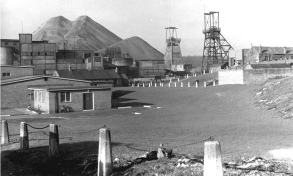
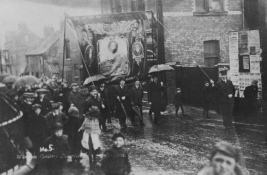
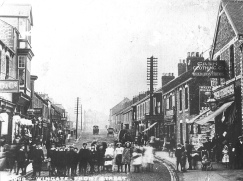
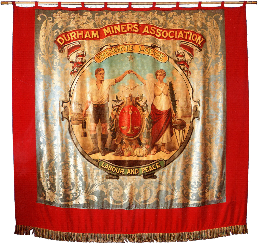
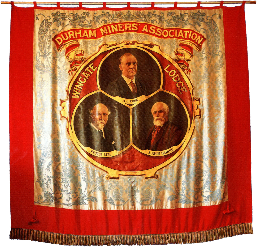
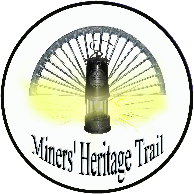
In Wingate Wingate Grange Lord and Lady pits had a capital investment of £60,000 and were sunk on either side of a small fault; coal was drawn from 1839 but not without difficulty. The water in the colliery exhibited corrosive properties not found elsewhere and at the rate of 1,800 gallons per minute this caustic liquid was pumped to the surface.
A chemical solution was finally found but not before considerable expense to the colliery for seven or eight years. In 1841 a school was built on the Burdon estate with colliery timber, joiner work, and donations from Lord and Lady Howden. Private subscription enabled provision to be made for 140 boys, girls and infants.In 1906 disaster struck Wingate Grange Colliery when an explosion killed 26 men and ponies.
The colliery closed 1962.
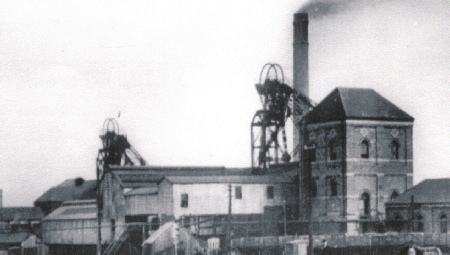
Wheatley Hill Colliery Sinking of the shafts commenced Monday 29th July 1867, in the presence of John Pattson esq., on behalf of the original owners, The Thornley Coal and Coke Company. Shafts Sunk 1869
No. 1 pit – Harvey Seam
No. 2 pit – Hutton Seam
1885 – Colliery purchased from bankrupt owners by The Weardale Iron and Coal Company, owners of the colliery until the mines were nationalised by the Government in 1947. 1947 – National Coal Board - until closure in May 1968
John Wilson M.P. 1837 - 1915 Born in Greatham, Hartlepool. He entered the pits as a 13 year old at Ludworth and worked in many pits in the North East, where from the age of 15 years, his exploits as a strike ringleader and union representative grew. He worked for many years at Wheatley Hill pit until he lost his job due to his part in the putt pay dispute. He set up as a village printer and carried on working for the miners of the area.In 1882 he was elected Treasurer of the DMA, three years later becoming M.P. for Houghton-le-Spring.
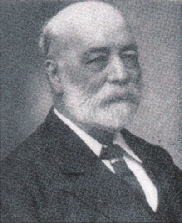
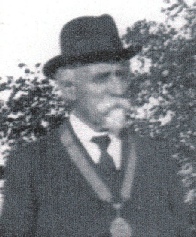
Peter Lee 1864 – 1935 Born in Trimdon Grange, Peter Lee wandered far in his early years, working from the age of 10 years in cotton mills, quarries and 16 collieries by the age of 22 years.
As a 16 year old he was hewing coal. He educated himself at night school and used this education to travel, working as a miner in both the USA and South Africa. In 1902 Peter was employed by the miners of Wheatley Hill as their check-weighman and elected to the Parish Council in 1903, becoming Chairman. He was responsible for establishing the cemetery, sewerage system and street lighting in the village as well as the link roads from Wheatley Hill to Thornley and to Thornley Station. In 1919 Durham County Council became the first Council to be controlled by the Labour Party and Peter Lee became its Chairman. In the 1930’s he became General Secretary of the DMA - the much revered leader of over 100,000 coal miners in County Durham. On his death Peter Lee came back “home” to be laid to rest in the village cemetery that he had done so much to establish initially.
Miners' Heritage Trail in Wheatley Hill Sign 1
Roots of the village The lands on which the village developed have historically been referred to by a variety of names and give a good indication as to the origin of the village name – Whetlaw/Whetlawe/Quetlaw/Wheatlaine (1144 – Hugh Pinton), (1331 – Bishop Bury), (1451 – Robert Rhodes), (1480 – Jon Trowloppe and Richard Bainbrig)As historic names were mostly derived from observed physical features, it is suggested in Sir Thomas Eden’s book – “History of Durham County”, that the above names were derived from common features of this locality i.e. wheat, (as in grain grown for food) white (as the lands were often covered in a hoar frost) and law meaning land. Add the fact that the land is very undulating and hilly and the conversion to Wheatley Hill is easy to understand.
Founding Fathers
There have been many men and women over the years who have brought credit and honour to the village, or have served it with dedication and distinction. Whilst there isn’t room to credit all of them, two former residents have a special place in the history of the village.
Miners' Heritage Trail in Wheatley Hill Sign 2
Village Development
The original hamlet of Quetlaw was based on, and around the The Manor House (Rock Farm).
With the sinking of the colliery in the late 19th Century a rapid development took place around the mine itself. Over the years following expansion, “slum” housing clearance, development and re-development the village grew westward – away from its original location. Subsequent re-development of this same land to the south east of the Farm in 1980’s and the 1990’s, has seen this “original colliery housing” area developed for housing once more.
Time Line
Demolished Colliery Rows, Terraces and Streets

The Manor House – Rock Farm
At the centre of the original agricultural hamlet on which Wheatley Hill developed, the Manor House, as was, dates from the early/mid 16th century. It was built of local magnesium limestone and sandstone on a historic estate that can be traced back to the 12th century. The ownership of the estate and subsequently, the Manor House, which became East Farm and eventually Rock Farm, can be followed through a long line of owners and tenants to the present owners, who, on purchasing the farm in 1991, proceeded to restore and renovate the farm house, to its current condition.
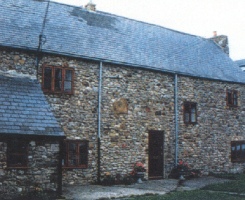
|
Plantation Street
|
Arne Street
|
York Street
|
Twelfth Street
|
|
John Street
|
Maria Street
|
Stockton Street
|
Thirteenth Street
|
|
Anne Street
|
Gullock Street
|
Stanhope Street
|
Fourteenth Street
|
|
Emily Street
|
Ford Street
|
First Street¹
|
Fifteenth Street
|
|
Smith Street
|
Pymans’s Street
|
Second Street
|
Ashmore Terrace
|
|
Elizabeth Street
|
Wolmerhausen Street
|
Third Street
|
Club Buildings
|
|
Grainger Street
|
Institute Street
|
Fourth Street
|
Stephens Terrace
|
|
Quarry Street
|
Shop Stree
|
Fifth Street
|
Wingate Lane²
|
|
Robson Street
|
Gowland Terrace
|
Sixth Street
|
|
|
Hirst Street
|
Weardale Street
|
Seventh Street
|
1946/47 Prefab
|
|
Patton Street
|
Durham Street
|
Eighth Street
|
Housing
|
|
Gothay Street
|
Sunderland Street
|
Ninth Street
|
Taylorson
|
|
Louisa Street
|
Darlington Street
|
Eleventh Street
|
|
Notes
First Street¹ - 1 – 5 remaining in 2002
Wingate Lane² - Originally built to house workers employed at the local quarry
Wheatley Hill Mining Monuments
Memorial Stone
To the 5 Wheatley Hill Mineworkers - one a boy of thirteen years - who were drowned by the inrush of water into the mine workings in 1871 and also the 4 miners killed as a result of an underground explosion in 1876.
This 1877 memorial, in the form of a red granite obelisk, was purchased by their mining comrades from Ludworth, Thornley and Wheatley Hill collieries and erected in their memory, alongside their graves, in Thornley Church Yard, which was the village cemetery at that time.
Pit wheel Memorial
This is erected on the reclaimed area of colliery rows that was Shop Street, opposite the site of the colliery.The memorial is in the form of two half pulley wheels set in a red brick raised plinth with a simple plaque of dedication.
Heroes - Each and Every one of them
Residents of the village have never been found wanting when the call to arms sounded. The roll call of the dead from the village shows volunteers that have fallen in both World Wars, Korea and other theatres of active service. Memorials to these fallen heroes can be found in various locations in the village.
There were a wide range of honours awarded to brave servicemen with links to Wheatley Hill, including the Victoria Cross awarded to an "adopted son" - Thomas Kenny, who lived in Darlington Street and was subsequently buried in Wheatley Hill cemetery.
We shall remember them!
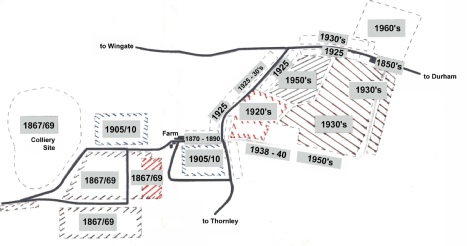
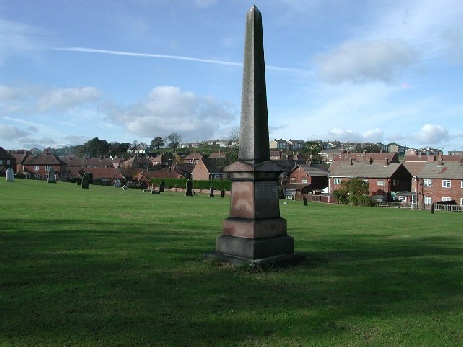
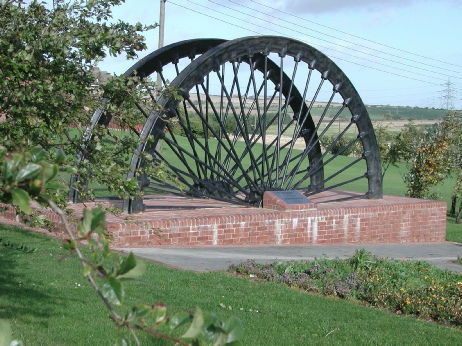
Miners' Heritage Trail in Deaf Hill, Trimdon Station
Trimdon Station has many names. Deaf Hill was originally a single family farm, though perhaps not very productive as the name is thought to derive from dead hill. The population of the later village expanded rapidly when the pit opened in 1869.
A serious flood in 1919 caused the pit to be closed for 6 months.
Trimdon Station was once part of Trimdon Colliery. The first pit to draw coal was in 1843. In 1846 the railway station was moved to Trimdon Colliery from then on the north of the village became known as Trimdon Station.
The railway was constructed to take coal to Hartlepool. The railway was also an important passenger link for travel to Wingate and Hartlepool. Trimdon Station was opened in 1851 and the arrivals and departures of trains became ‘the clock’ of village life. The station eventually closed to passengers in 1952 though coal traffic continued.
The Deaf Hill banner has a representation of the biblical parable of the Good Samaritan. It refers to the ideals of the mining union to help each other and its commitment to widows and orphans.
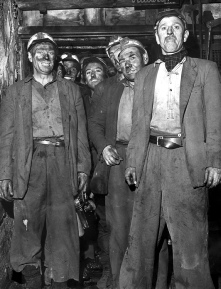
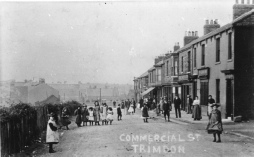
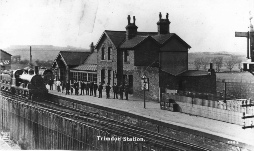
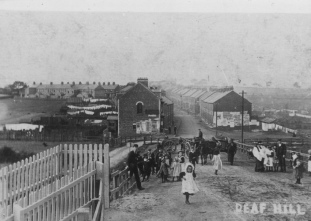
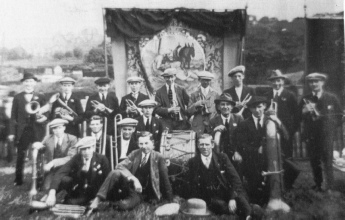
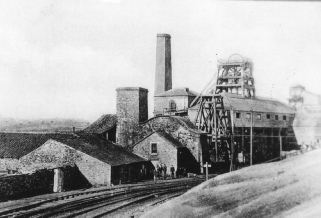
Commercial Street Trimdon Colliery
View from Railway Station
Miners' Heritage Trail in Thornley Sign 1
Thornley pit was sunk between 1832 and 1834 by the Thornley Coal Company. The first coal was brought to the surface in early 1834 and was of good quality. A new rail link was constructed via Castle Eden to Hartlepool where coal from Thornley was sent by sea to be traded in London.
Between 1831 and 1841, the time of the colliery opening, the population of Thornley increased from 56 to 2740. Housing conditions for the early miners were poor. Dirt floor dwellings were provided by the pit owners and ash and dung heaps behind the houses were the only sanitation. Water was transported from the well at Gore Hall and sold to miners’ families at a penny per bucket. Its not surprising that there were reports of outbreaks of cholera at the time.
In the early days of the pits, women, girls and young boys often as young as 6 or 7 were employed. Pit lads often worked 14 hours a day and were called from bed at 3am. Even when legislation was passed to restrict the lower age of the employment of boys to 10 years old, the pit was often the sole employer in villages and it was assumed that lads leaving school would go down the pit. In 1841 a 9 year Thornley lad, possibly having fallen asleep, left his ventilation trapdoor open and was killed with 8 others in an explosion resulting from gas being ignited in the naked flame of his candle.
Thornley miners played an important part in challenging the bond system. In the same way that agricultural workers were employed, the early miners were bonded for a year to the pit owner. The bond gave pit owners enormous power over their workers who could be fined or imprisoned for breaking the terms of their bond. On the 24th November 1843 sixty eight Thornley men withdrew their labour after a dispute about the weighing of coal which was the basis of their wages. The pit owner took them to court for breaking their bond and, although they were all found guilty and sentenced to prison, they were later acquitted.
There were numerous pubs and dancehalls. Thornley also had its own court and police cells. The court met at weekends so that troublemakers from Saturday night could be processed and released ready for the first shift on Monday.
The mine was closed in 1969, the washeries in 1972 and the pit heaps were reclaimed in 1974.
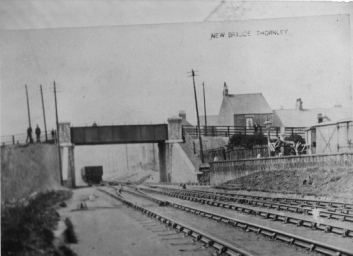
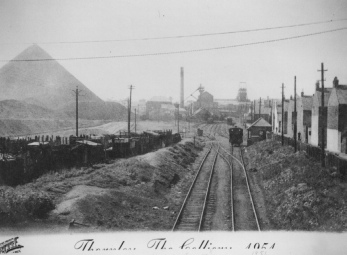
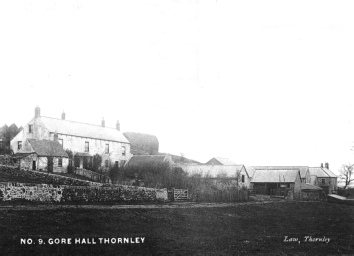
Miners' Heritage Trail in Thornley Sign 2
Before coal mining Thornley had a rich history.
The Manor of Thornlaw was most famously ruled by the Trollop family, who offered a place of safety to Catholics in the Elizabethan period.
Parts of the village of Thornley are named after districts of the manorial estate, for example Thornlaw and Gore Hall.
At nearby Signing Hill, travellers made the sign of the cross when first coming in sight of Durham Cathedral.
Until 1844 Thornley was part of the parish of Kelloe, but became an independent parish after the opening of the pit in 1835 and rapid population expansion.
Thornley miners were at the forefront of the 30 year long struggle to establish a recognised trade union to represent miners across County Durham. In the face of economic exploitation and dangerous conditions at work, the union was important to ensure their collective protection and welfare.
The first delegate meeting of the Durham Miners Association was held at the Half Way House in Thornley in 1869 (this has since become the Crossways Hotel). A picnic was held in a field nearby and this is thought to be the predecessor of Durham Miners Gala. The following year a picnic was held in Wharton Park in Durham and in 1872 a great demonstration of miners was held on Durham Race Course. The Thornley banner was used as a backdrop to the speeches.
‘’ Every Big Meeting day, up Thornley Main Street,Along with the band we danced to the beat ….’’
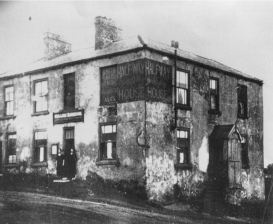
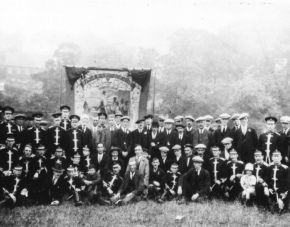
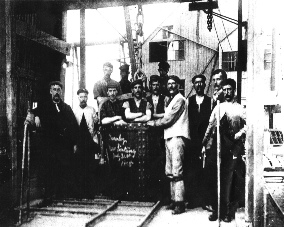
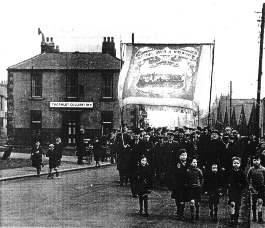
Barrel of Grapes/Halfway HouseNow Crossways Hotel
Banner with band and union officials
Banner being marched passed the Colliery Inn
Miners' Heritage Trail in Station Town
Sinking of the Hutton Henry Colliery began in 1871 and the first coals were drawn in 1876. It was to survive for merely two decades. Station Town was built to house its miners and gave hope to the decaying village of South Wingate in which Rodridge Colliery was owned by the same company. The company ploughed the profits from Hutton Henry into Rodridge but it was wasted. It ought to have provided new and better machinery for Hutton Henry Colliery which was closed in 1897 because of flooding.
For some reason there were not many dwellings built near the colliery. At that time it was very common for rows of colliery streets to cluster near the pit head, only one row, Heath View was built on the site.
By chance the boundary between Wingate and Hutton Henry townships ran along the beck, and the development was in next parish and required another name. The railway Station was the most southerly building of Wingate and so the name of Station Town was given to the new settlement.
Some of the streets were named after prominent people Fredrick Acclom Milbank gave his name to Acclom Street and Milbank Terrace. Vane Street derived its name from the Vane Tempest family of coal owners. Rodridge Street was named after Rodridge Farm.
Growth continued despite the colliery closure probably because of it's affinity to Wingate, then a developing and prosperous colliery.
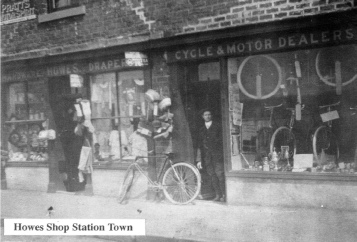
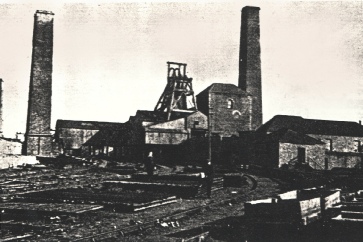
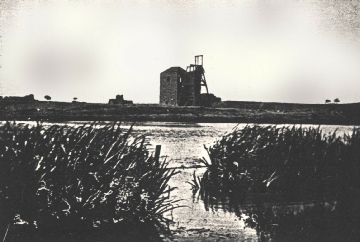
Hutton Henry Colliery 1898
Hutton Henry Colliery 1928
Miners' Heritage Trail in Shotton Colliery
Shotton Colliery was born with the sinking of the pit in 1833 by the Haswell Coal Company, though the first coal wasn’t produced until 1841.
The development of the colliery drastically changed the idyllic countryside setting of the village, which until then had been dedicated to agriculture.
By 1851 the village had grown considerably with the population rising from a few hundred to 1,607. There were 1,300 men and boys occupied with work connected to the colliery.
At first the colliery was connected by wagon way to Seaham Harbour but in 1855 a new link was constructed to the Hartlepool – Sunderland railway.
The nearby brickworks used saggerclay from the mine and offered an additional source of local employment for both men and women until its closure during the 1960’s. The brickworks produced 120,000 wire cut common bricks per week.
Boom and bust created good times and bad times and the colliery closed in 1878 for 23 years. The houses were boarded up but remained undamaged and the former ghost town was reoccupied when the pit reopened in 1901. It was now owned by Horden Coal Company. Shotton pit was a thriving concern and profitable enough to pay for the sinking of the Blackhall pit in 1908. In 1906 it was producing 392,000 tons a year and had 1163 employees. Shotton pit survived for a further 72 years.
The 1920’s and 1930’s were a time of strikes, lockouts and depression. Accounts from the 1926 strike tell of people collecting dust from the Shotton heap and mixing it with water to make balls for burning on domestic fires. In 1930’s the depression caused the export of coal to slump.
In 1972, the year of the pit’s demise, the BBC made a documentary called ‘A Month of Sundays’ about life in Shotton during a national miners’ strike, but this wasn’t Shotton’s first claim to fame! In his publication ‘An English Journey’ the famous author J.B. Priestley wrote of Shotton… ‘If there is a queerer village in all England than this, I have never seen it.’ He described the notorious pit heap as ‘a man-made smoking hill’ which he hoped would always be there ‘as a monument to remind happier and healthier men of England’s old industrial greatness and the brave days of Queen Victoria’. He returned in the 1970’s to retrace his steps for a television documentary and though his rhetoric was not quite so slating, he still didn’t have a very high opinion of the village. If only he’d visited a couple of years later, he would not have recognised the ‘tip’ – which had been removed and landscaped to form the airfield it is today.
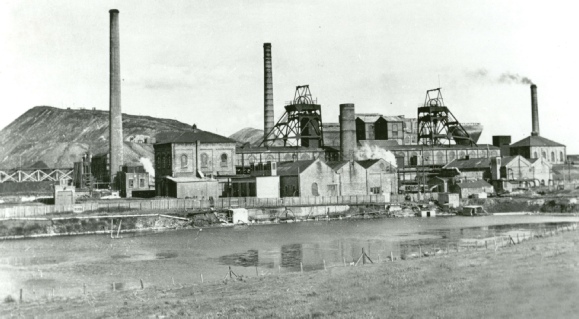
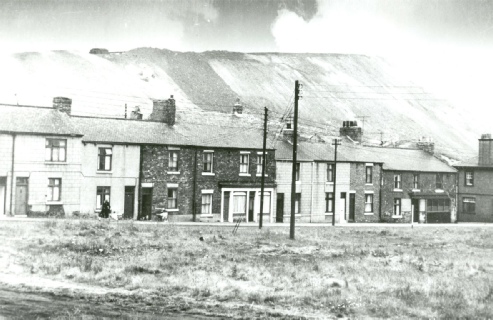
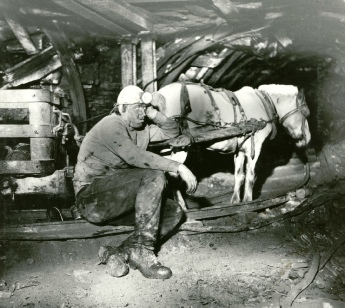
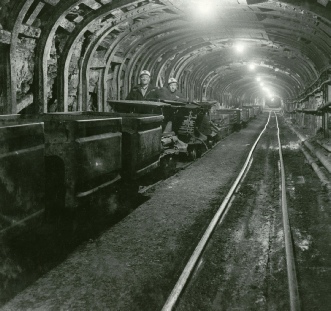
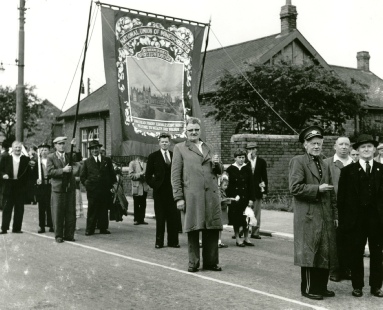
View of the colliery with the pit heap in the background and the pit pond in the foreground.
Front Street (‘over the line’) with the pit heap behind. The Beehive Public House and the Red Brick Inn are also featured.
Timber leader – Alan Hind with pit pony.
Salvage work in progress before the pit finally closed.
NUM Shotton Lodge Banner returning from parade at the annual Durham Miners’ Gala.
Bridge that was over railway line.
Thornley Colliery from bridge over B1279 1951 Pit heap in background
© Wheatley Hill Heritage Centre 2018






































